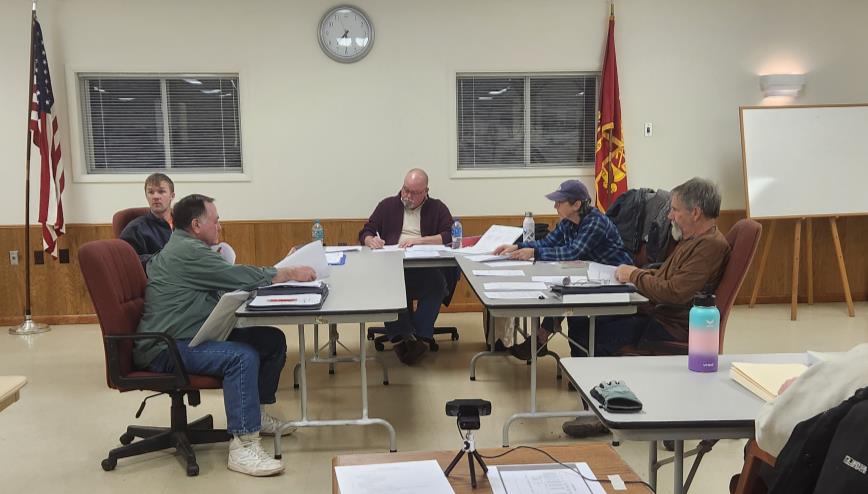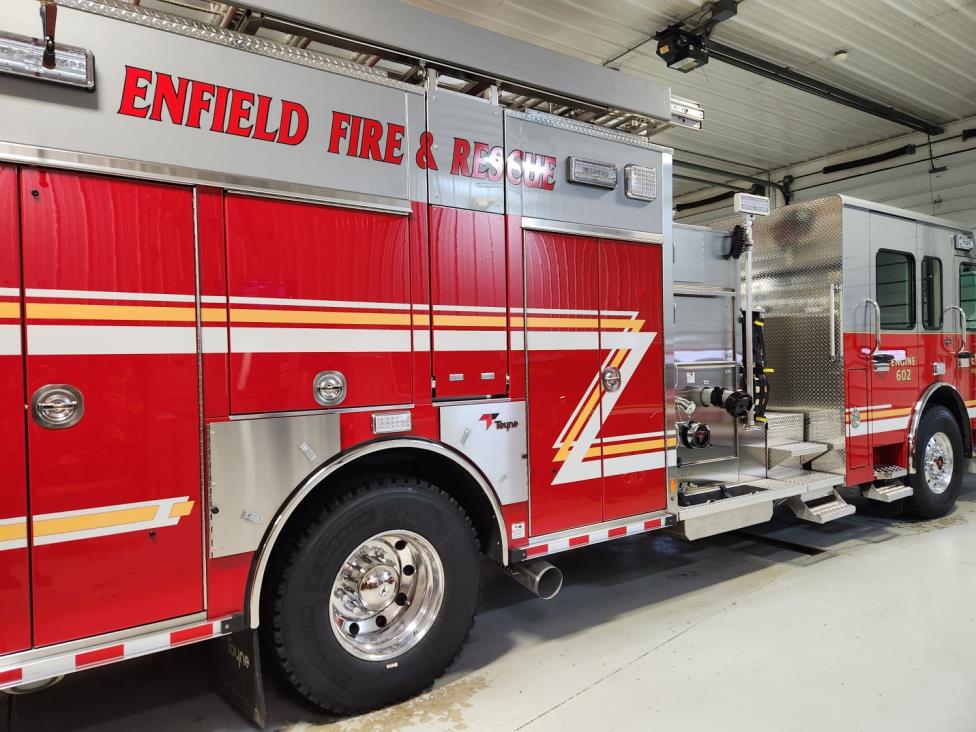by Robert Lynch; March 20, 2024
In a sense, eight months of preparation, public voting, calculation and on-and-off controversy concerning Enfield’s fire-future came down to a string of votes during a two-and-a-half-hour meeting Tuesday night at the Enfield Fire House.

A shiny new, expensive piece of Enfield fire apparatus—a pumper engine that cost-conscious critics had once suggested be sent back to the factory—secured its final commitment from the local district’s Board of Fire Commissioners as the Board unanimously authorized the $825,000 engine’s ten-year bonding at an interest rate of just over 4.6 per cent.
The bonding authorization came as one of five significant votes taken by the Board of Commissioners Tuesday, decisions that solidified the transfer of power and assets from both the Town of Enfield and the non-profit Enfield Volunteer Fire Company (EVFC) to the recently-formed Enfield Fire District, a transfer directed by the Town Board last June.
“We made good progress tonight,” Fire Commissioners’ Chairman Greg Stevenson remarked after the meeting. He commended the Board’s five members for reaching decisions without disagreement.
In addition to bonding the pumper, the Board authorized the uncompensated transfer of fire apparatus from the EVFC to the Fire District. It approved a one-year’s lease of the fire house from the Fire Company. And Commissioners authorized a second lease that continues EVFC’s ownership of a tanker truck until its low-interest loan is paid off.
Stevenson expects to sign bonding documents March 26th at the Town Hall. They’ll then be sent to the Bank of Greene County in time to close on the bonding by April first. Bond financing will then continue through 2034.

An amortization schedule, shared at Tuesday’s meeting, put the truck’s total ten-year interest charges at $210,363.50, raising the pumper’s overall cost to $1,040,363.50, principal plus interest. Add to that nearly $37,000 in bank interest charges incurred between when the EVFC bought the truck last year and the April bonding date.
Two weeks earlier, Stevenson, on the advice of Fire District counsel Mark Butler, had delayed the bonding decision in hopes the interest rate might fall. It did not. But, said Stevenson, to console the Board, “It didn’t go up, either.”
The Bank of Greene County, with headquarters south of Albany, has become a favorite for local fire apparatus bonding. It’s where the EVFC financed with traditional bank loans the initial purchase of the pumper. It also borrowed there for the less-expensive tanker truck, bought in 2020.
The Bank of Greene County has established the fire service as a “niche market,” Stevenson explained after the meeting. The District’s lawyer, Mark Butler, assuredly “shopped around, but couldn’t find a better rate,” the Board Chairman reported.
After the Enfield Town Board created the Enfield Fire District last June and transferred fire service oversight to it last August first, an appointed interim Board of Commissioners began laying plans for apparatus transfer and the financing for the newly-bought pumper, as well as for the three-year-old tanker, whose bank loan had yet another three years to run.
In a hastily-called, and hence, controversial referendum last October, the appointed Board put to voters a proposition to bond both trucks, the pumper for up to 20 years. Voters narrowly approved both bonding resolutions. But when the newly-elected Board took over from the appointed Board in January, it scrapped plans to bond the tanker, and made clear that a 20-year term was too long to bond the pumper.
At their meeting January 23rd, Board members were torn between bonding the more expensive truck for ten years or for as few as seven. They gave the 10-year plan a slight preference. The decade-long duration was never given the official OK until Tuesday’s meeting.
A 20-year time frame was “too long, too much, and doesn’t work,” Stevenson had informed the Board in January, based on his conversation with attorney Butler.
By contrast, the two-decade-long term was the preference of one or more of the earlier-appointed Commissioners, persons no longer on the Board. And it was also the preference of the District’s former lawyer, Brad Pinsky, whom the current Board wasted no time to replace this January.
The 10-year serial bonds now to be purchased work much differently than does a typical auto loan. Unlike an auto loan, where monthly payments stay constant, bond payments are front-loaded and vary year-to-year. The bonds will repay one-tenth of the truck’s principal annually ($83,000/year). Accordingly, yearly payments are higher at the start. $118,482 would be paid next year; $87,399 in 2034. The computed 4.6082% interest rate is an average, of sorts.
At its last meeting, March 5th, Fire Commissioners had encountered a snag. In crafting last October’s bonding proposition, approved in a referendum, former attorney Pinsky had underestimated the transitional interest to have been incurred between EVFC’s purchase of the pumper and when the bank loan would be exchanged for the bond this April. By law, bonding could go no higher than the $830,000 voters had authorized. But the truck’s purchase price, plus accrued interest, was now calculated to grow to more than $866,000 by the bonding date. The dilemma left Commissioners with a nearly $37,000 gap to fill.

Tuesday, Commissioners found a way to fill it. First, they tapped $27,506 from a bonding line in their current budget, money that won’t be needed right now because bond payments won’t begin until next year. They then filled the $9,455 remainder by cutting back the $50,000 in legal fees that Pinsky had advised the prior Board to set aside for him.
Pinsky’s successor, Mark Butler, expects to charge the Fire District less money than Pinsky had estimated for himself.
To take care of the second truck, the tanker, the one not bonded, the Board Tuesday approved a lease agreement with the EVFC, one whereby the Fire Company will pay three remaining $72,449 annual bank payments, and the Fire District will reimburse it. It’s a pass-through. EVFC will make no profit on the deal.
The Board will lease, rather than bond, the tanker because its current bank interest—negotiated years ago, when rates were far lower—is only 3.74 per cent. A bond right now could never beat it.
“It doesn’t do the taxpayer’s pocketbook any good” to hold to the original bonding plans, Stevenson said.
Quickly decided, after successful negotiations with the EVFC’s leadership, Fire Commissioners Tuesday approved a one-year lease for the Enfield Fire House, still owned by the Fire Company. For a variety of reasons, neither current nor former commissioners had ever seriously considered wresting fire station ownership from the EVFC. This year, the Fire District will pay $72,000 to lease the building. Terms will be renegotiated annually.
And in its final of five unanimous actions Tuesday, Fire Commissioners approved the voluntary transfer to the Fire District—without consideration—of an exhaustive inventory of EVFC apparatus. The transfer included ten other fire vehicles, apart from the new pumper and the partially-paid tanker. It also included hoses, radios, boots, turnout gear, and just about anything else volunteers use to fight a fire or save a life.
This writer tapped the folding table the Board had just used to hold its meeting, one that arguably had seen better days. “Is this included?” I asked Stevenson.
“Not yet,” he answered.
###

